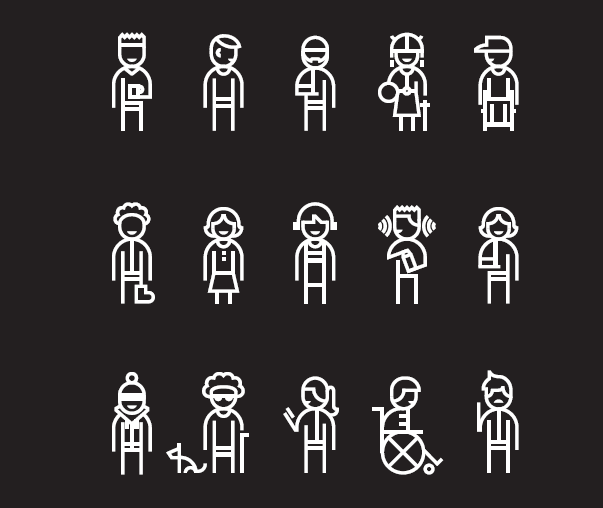In the first part we talked about introduction to UX and the foundations of User Experience design things like the user-centered mindset, The key stages of the UX process and iteration in design. Today, We will talk about good usability explore some of UX tools.
Content
- What is good usability ?
- Some of the key factors that constitute ‘good usability’
- Real life examples
- Who makes a good UX
- Explore some of the tools of the trade used in UX Design
1. What is 'good usability'?
We're going to look at some of the key factors which make an experience delightful.
- Some good design principles.
- Some real life examples.
- Who makes a good UX.
1. Some good design principles.
Now, there isn't really a checklist of good design principles that you have to follow in order to get the perfect UX or really good usability.
But you know when you've got good UX, because it feels very natural and easy to understand. So, there are some things that you can follow to make sure that your customer has the best experience.
- Making it simple and easy for them to understand.
-
- Intuition is based on past experience, cumulatively, and determines some level of expectations.
- So customers increasingly expect to log onto a site or a system without any training and being able to navigate it very quickly.
- Intuitive design helps customers to navigate your site easily without having to click on lots of options or menus to find the information they want.
- Intuitive design it’s not really about intuition at all, but about researching your users, their goals, their biases and generally who they are to determine what the best design solution. is for them.
-
It has to be engaging/attractive.
- What this means is that customers have to come away having a delightful experience. And this means that they come away feeling good. They come away feeling like they want to come back.
-
It has to be efficient.
- The fewer clicks to complete a task, the better, So can the user do in three clicks what they used to have to do in eight?
-
They have to feel well-supported.
- So if they need help and advice, it has to be right there for them.
-
It has to be easy to recover.
- So if the user makes some sort of mistake or missed navigation, it has to be quite easy for them to get back on track.
-
Consistency across different pages
Has to be consistent (same template) across all the different pages of your website. So it's quite helpful to follow the common industry standards that your user's already used to. This includes things like:- Having your menu at the top or the left of your screen
- Having the icons and using those same icons throughout your website.
- Having the Next button at the bottom right hand corner of your screen.
- Reusing the same fonts, the same colors and sizes across your website. And this might seem like really minute details at the moment, but they make a huge impact on your UX so it's really important that you pay attention to this.
-
- Accessibility is also an important aspect of usability
- Accessibility means it can be used by everyone
- In practice, accessibility is about designing products and services to accommodate the needs of all potential users regardless of their ability.
- When designing, you should consider the number and type of potential accessibility issues or disabilities users may have. Disabilities include visual impairment (e.g. color blindness), motor/mobility (e.g. wheelchair-user concerns), auditory (hearing difficulties), seizures (photosensitive epilepsy) and learning (e.g. dyslexia).
- By designing to reach all ability levels, you’ll create designs anyone can use and enjoy whatever the context. Designing for accessibility helps all users and is also known as "universal design". You can increase accessibility by applying Universal Design principles which you can read more about
2. Some real life examples.
- What I want you to do for this is have a good think about your favorite apps or websites and think about what you like about them and what is it that keeps you coming back to them.
- Now what I want you to think about is some of those apps that you've deleted or those websites that you've left in frustration.
- Think about what it was that turned you off.
- Think about things that you do and that you don't like about some of these apps on the websites that you use.
- You might find that there are some common themes that emerge and you might even surprise yourself with what impacts your experience.
- If you're struggling for ideas, think of the popular ones, such as Netflix, Facebook, YouTube, or Snapchat.
- Think about what it is that keeps users returning to these.
3. Who makes a good UX.
So now, we're going to look at who makes a good UX design or what makes a good UX team.
The answer to this is it's not just about having a really great designer on board. It's actually more about having an effective UX team in place. And this UX team needs to have people from all different sort of backgrounds who bring different skills and perspectives to the table.
So you might have someone who specializes in psychology or market research and then you have someone who's good at graphic design and someone with a really technical understanding to be able to build these cool widgets.
Also, It's also really crucial to have someone who's good with people on your team to get that all important user feedback along the way.
So working together is the most important thing here. It's being flexible enough to adapt that design based on all these different inputs.
Collaboratively working with different people from different backgrounds is also really important. They'll be constantly asking these questions of why and what if and that's going to help you achieve your best outcome.
As long as you have an attitude of an open mind, curiosity, and empathy, you're going to be able to ensure that user experience, the user is always at the center of your design.
Resource:
- GUIDELINES FOR CREATING YOUR PRODUCT OR WEBSITE
- THE IMPORTANCE OF USER EXPERIENCE WITH REAL-WORLD EXAMPLES
- DESIGN KIT
- THE 7 PRINCIPLES OF UNIVERSAL DESIGN - Accessibility
- DO'S AND DONT'S ON DESIGNING FOR ACCESSIBILITY
2. Explore some of the tools of the trade used in UX Design
For further information, you can explore some of the tools of the trade used in UX Design:
- Wireframing or sketching tools: A visual guide to simply show what an app or web page will look like. It suggests the structure of a page, without including all the details about how the final design will look or function. A wireframe is made up of simple lines and boxes and can map the interactions on a page and where each section links to. You need to create a lot of sketches and wireframes - visual guides to how an app will look like. Can be digital or hand drawn. Pen and paper, Balsamiq Mockups, Sketch, Axure, Omnigraffle. Wireframing programmes allow you to do that quickly.
- Design prototyping tools: A prototype is an early, model, or release of a product. often interactive sample of a product. You can show it to your users so that they can imagine the experience of using the finished product before developing it. So prototype, It’s built to test whether a product will work if it is developed further, and how it can be improved We can use: Invision, Axure, Marvelapp, Flinto, UXPin, Proto.io, Principle, Adobe XD
- Image editing software: You will probably want to include images in your designs. Learning to work with image editing software means you can easily edit your designs. We can use: Adobe photoshop, Illustrator, Sketch, Pixlr 4.Post-its and flipchart paper: A lot of the underlying user research and the testing of the prototypes is done in workshops with the users. Paper-based brainstorming is still key in these workshops.









Latest comments (0)